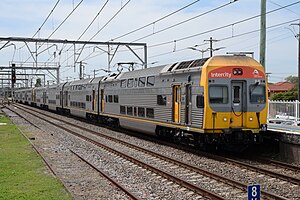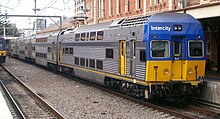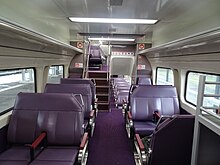
The T sets, also referred to as the Tangara trains, are a class of electric multiple units that currently operate on the Sydney Trains network. Built by A Goninan & Co, the sets entered service between 1988 and 1995, initially under the State Rail Authority and later on CityRail. The T sets were built as "third-generation" trains for Sydney's rail fleet, coinciding with the final withdrawals of the "Red Rattler" sets from service in the late 1980s and early 1990s. The Tangaras were initially built as two classes; the long-distance G sets and the suburban T sets, before being merged after successive refurbishments.

The 4D was a prototype double deck electric multiple unit built for the Public Transport Corporation in Victoria, Australia, for operation on the Melbourne railway system. It remains the only double deck train to have ever operated in Melbourne. The train's name stood for "Double Deck Development and Demonstration."

The 3000 class and 3100 class are a class of diesel railcars that operate on the Adelaide rail network. Built by Comeng and Clyde Engineering between 1987 and 1996, they entered service under the State Transport Authority before later being operated by TransAdelaide and Adelaide Metro. Trains are typically coupled as multiple units, though the 3000 class are also able to run as single units when needed. In total, 70 railcars were built and are expected to be retired between 2030 and 2032.

The Harris trains were the first steel-bodied electric multiple unit (EMU) trains to operate on the suburban railway network of Melbourne, Victoria, Australia. They were introduced in 1956, by the Victorian Railways, and last operated in 1988, although a number of the carriages were converted for other uses and are still operating. They were named after Norman Charles Harris, Chairman of Commissioners of the Victorian Railways, between 1940 and 1950.
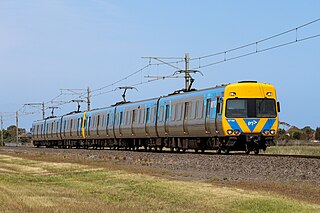
The Comeng is a class of electric multiple unit (EMU) operating on the suburban railway network of Melbourne. Built by their namesake Commonwealth Engineering, the trains were introduced in 1981 as a replacement for the Tait and Harris trains. In total, 190 three-car trainsets were built, although only 115 remain in service and are expected to be retired by 2030.

The C sets were a class of electric multiple units that operated on Sydney's suburban rail network from 1986 up until 2021. Built by A Goninan & Co between 1986 and 1987, they were introduced into service by the State Rail Authority, before later being operated under CityRail and Sydney Trains. A total of 56 carriages were built, with the last sets being withdrawn from service in February 2021, having been gradually replaced by Waratah A & B set trains.
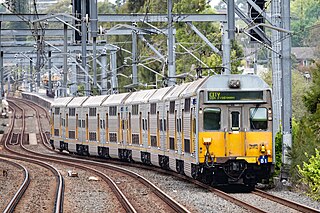
The K sets are a class of electric multiple units (EMU) that currently operate on the Sydney Trains network. Built by A Goninan & Co, the K sets first entered service in 1981 operating under the State Rail Authority, and later CityRail. The carriages are of stainless steel, double deck construction and share much of their design with the older S sets. All of the 40 K sets originally built remain in service but one 4 car set. The K sets are currently the oldest in the Sydney Trains fleet.
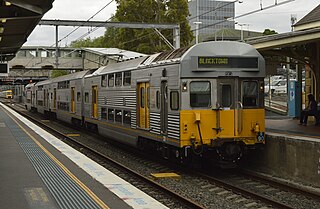
The S sets are a class of electric multiple units (EMU) that operated on Sydney's suburban rail network from 1972 up until 2019. Originally entering service under the Public Transport Commission, the sets also operated under the State Rail Authority, CityRail and Sydney Trains. Prior to their retirement, the S sets were the last class in the Sydney Trains fleet to not be air-conditioned, earning them the nicknames "Tin cans" and "Sweat Sets". They were also nicknamed "Ridgys" because of their fluted ("ridged") stainless steel panelling; they shared this nickname with similar looking K sets and C sets. Their stainless steel appearance was also shared with the intercity V sets and U sets. All remaining sets were withdrawn from service in June 2019.

The Endeavour Railcars are a class of diesel multiple units (DMU) operated by NSW TrainLink on passenger rail services in New South Wales, Australia on the Hunter, Blue Mountains, Southern Highlands and South Coast lines. They are mechanically identical to the Xplorers, but are fitted out for shorter travel distances. All 30 carriages were built by ABB's Dandenong rolling stock factory.
The Sydney Trains fleet serves the metropolitan lines within Sydney, Australia. All of the rolling stock are double-deck electric multiple units and operate mainly as eight carriage sets.

The Sydney Trains H sets, also referred to as the OSCAR trains, are a class of electric multiple units (EMU) currently operated by Sydney Trains on its intercity routes and some Sydney suburban routes. Built by UGL Rail in Broadmeadow, the H sets first entered service under the CityRail brand in December 2006, with the last in December 2012. Their introduction allowed for the retirement of some second-class V set carriages. As long-distance trains, the H sets share a similar overall layout and design to the previous Tangara G sets. Currently operating as 55 four-carriage sets, the H sets now operate between Sydney, Central Coast and Newcastle and between Sydney and the South Coast.
The railways of New South Wales, Australia, use a large variety of passenger and freight rolling stock. The first railway in Sydney was opened in 1855 between Sydney and Granville, now a suburb of Sydney but then a major agricultural centre. The railway formed the basis of the New South Wales Government Railways. Passenger and freight services were operated from the beginning. By 1880, there was a half hourly service to Homebush.
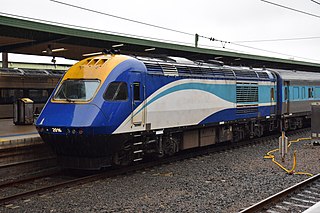
The New South Wales XPT is a class of diesel-powered passenger trains built by Comeng and ABB. Based on the British Rail-designed High Speed Train, each XPT set comprises two XP power cars in a push-pull configuration and, between them, between four and seven passenger carriages.

The Silver City Comet was a train service that operated from September 1937 until November 1989 between Parkes and Broken Hill in western New South Wales. It was the first air-conditioned train in Australia.

The Metro Cammell EMU is the oldest variation of electric multiple unit that operates on the MTR rapid transit railway system in Hong Kong. A total of 768 cars were built by Metro-Cammell in England between 1977 and 1994, and refurbished from 1998 to 2001 by United Goninan.
The New Deal for Country Passengers was a timetable introduced on 4 October 1981 in Victoria, Australia which revolutionised the provision of country passenger railway services in that state. Thirty-five little-used passenger stations were closed, rolling stock utilisation was improved, and new rolling stock introduced. The timetable and associated service changes resulted in an average patronage growth of 8.7% per year, from 3 million in 1981 to 5.6 million passengers in 1990/91.

The Taiwan Railway EMU100 series was a set of rail cars fabricated by British Rail Engineering Limited and the General Electric Company in 1976 that has operated in Taiwan. The alternating current electric multiple unit (EMU) fleet entered full squadron service in 1979, and was withdrawn from service in 2009. This class of railcars were the first to operate on the electric Tzu-Chiang Express. Due to the unit's British origin, rail buffs have variously nicknamed them "British Girl", "British Lady", or "British Grandma".
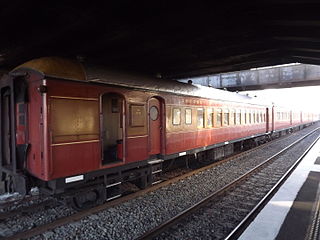
The N type carriage stock was a type of steel passenger carriage operated by the Department of Railways New South Wales and its successors from 1939 until the late 1980s.
The New South Wales stainless steel carriage stock was a type of passenger carriage operated by the New South Wales Government Railways from 1961 until 1993.
The NSW TrainLink fleet of trains serves the areas outside Sydney, Australia, mainly interurban and interstate lines. The NSW TrainLink fleet consists of both diesel and electric traction, with the oldest of the fleet being the V sets and the youngest being the H sets.
